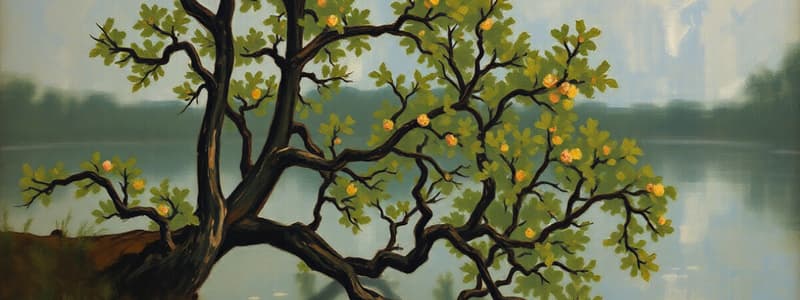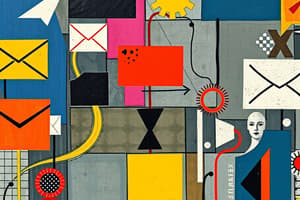Podcast
Questions and Answers
Which of the following best describes 'media literacy'?
Which of the following best describes 'media literacy'?
- The ability to access, analyze, evaluate, and create media in a variety of forms. (correct)
- The ability to program and develop new media technologies.
- The ability to use computers and other digital devices.
- The ability to understand historical events through media.
Information literacy primarily focuses on using social media effectively.
Information literacy primarily focuses on using social media effectively.
False (B)
Define 'technology literacy' in your own words.
Define 'technology literacy' in your own words.
Technology literacy refers to the ability to responsibly, appropriately, and effectively use technological tools.
The ability to engage with media and information providers effectively, as well as develop critical thinking and lifelong learning skills is known as Media and Information ______.
The ability to engage with media and information providers effectively, as well as develop critical thinking and lifelong learning skills is known as Media and Information ______.
Match the media examples with their corresponding historical periods:
Match the media examples with their corresponding historical periods:
Which of the following is an example of media from the pre-industrial age?
Which of the following is an example of media from the pre-industrial age?
The Industrial Age was characterized by a decline in book production due to new technologies.
The Industrial Age was characterized by a decline in book production due to new technologies.
How did the discovery of fire impact communication and information sharing in the Pre-Industrial Age?
How did the discovery of fire impact communication and information sharing in the Pre-Industrial Age?
Which material was primarily used for writing surfaces in ancient times, made from the pith of a plant?
Which material was primarily used for writing surfaces in ancient times, made from the pith of a plant?
The _____ is the term for paintings and engravings found on cave walls or ceilings, dating back to around 38,000 BCE.
The _____ is the term for paintings and engravings found on cave walls or ceilings, dating back to around 38,000 BCE.
Flashcards
Literacy
Literacy
The ability to identify, understand, interpret, create, communicate, and compute using written materials across different situations.
Media
Media
Physical objects used to communicate, like radio, TV, computers, and film.
Media Literacy
Media Literacy
The ability to access, analyze, evaluate, and create media in various forms.
Information
Information
Signup and view all the flashcards
Information Literacy
Information Literacy
Signup and view all the flashcards
Technology Literacy
Technology Literacy
Signup and view all the flashcards
Media and Information Literacy
Media and Information Literacy
Signup and view all the flashcards
Cave Paintings
Cave Paintings
Signup and view all the flashcards
Clay Tablets
Clay Tablets
Signup and view all the flashcards
Papyrus
Papyrus
Signup and view all the flashcards
Study Notes
- Literacy is the ability to identify, understand, interpret, create, communicate, and compute using printed and written materials in varying contexts.
- Literacy includes a continuum of learning, where individuals achieve their goals, develop knowledge, and participate in society.
- Media refers to physical objects used to communicate, including mass media like radio, television, computers, film, etc.
- Media encompasses any physical object used to communicate messages.
- Media is traditionally a source of credible information through an editorial process determined by journalistic values, with editorial accountability attributed to an organization or legal person.
- Media has been recently used to include new online media.
- Media literacy means the ability to access, analyze, evaluate, and create media in various forms.
- Media literacy aims to empower citizens by providing them with the competencies (knowledge and skills) necessary to engage with traditional media and new technologies.
- Information is a broad term that covers processed data and knowledge derived from study, experience, instruction, signals, or symbols.
- Information literacy id the ability to recognize when information is needed, locate, evaluate, and effectively communicate information in various formats.
- Technology literacy iis the ability of an individual to responsibly, appropriately, and effectively use technological tools, either working independently or with others.
- Media and information literacy are essential skills and competencies that allow individuals to engage effectively with media and other information providers.
- Media and information literacy also develop critical thinking and life-long learning skills to socialize and become active citizens.
Evolution of Media
Pre-Industrial Age (Before 1700s)
- Fire was discovered, paper was developed from plants, and weapons/tools were forged with stone, bronze, copper, and iron.
Examples of Pre-Industrial Age Media:
- Cave paintings (also known as "parietal art"), which are numerous paintings and engravings on cave walls or ceilings, existed around 38,000 BCE.
- Clay tablets were used as a writing medium, especially for cuneiform.
- Cuneiform, one of the oldest forms of writing, was used for over 3,000 years in 15 languages.
- Papyrus is made from the papyrus plant.
- Papyrus was used in ancient times as a writing surface for documents, rolled up into scrolls.
- Acta Diurna in Rome (130 BC)
- Dibao in China (2nd Century)
- Codex in the Mayan region (5th Century)
- Printing press using wood blocks (220 AD)
Industrial Age (1700s-1930s)
- People used steam power and developed machine tools.
- Iron production along with manufacturing of various products, including books through a printing press was established.
Studying That Suits You
Use AI to generate personalized quizzes and flashcards to suit your learning preferences.
Related Documents
Description
Explore the definitions of literacy and media. Literacy encompasses the ability to understand, interpret, and communicate using written materials. Media literacy involves accessing, analyzing, evaluating, and creating media in various forms, empowering citizens to engage with traditional and new technologies.




